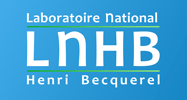Gamma-ray spectrometry
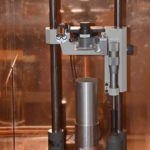
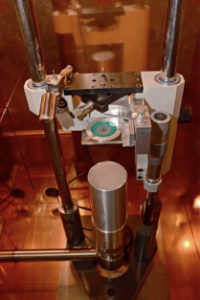 Photon spectrometry is a widely used nuclear measurement technique for identifying and quantifying X- and gamma-emitting radionuclides in any kind of sample.
Photon spectrometry is a widely used nuclear measurement technique for identifying and quantifying X- and gamma-emitting radionuclides in any kind of sample.
It is a non-destructive technique which does not require specific sample preparation. Conventional spectrometers are designed around solid-state detectors, typically high-purity germanium (HPGe).
X-ray spectrometry is particularly focused on the energy range below 10 keV and requires the implementation of specific techniques, while gamma-ray spectrometry studies photons with energies up to 2.5 MeV.
Radionuclides emit X- or gamma-rays with specific energies, whose interactions within the detector depend on several parameters (geometry or conditioning: physical shape of the object, density, quantity, type of container, energy of the emitted photons, size, shape and type of detector, etc.).
These interactions produce electrical pulses at the output of the detector. These are processed by an analog or digital acquisition chain that amplifies and shapes the pulses before converting these, to form the energy spectrum.
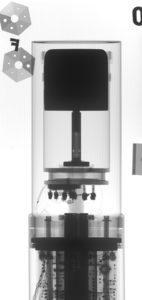
The energy range extends from a few keV to a few MeV. There are about ten HPGe detectors at LNHB used for gamma and X-ray spectrometry, each being adapted to a specific energy and/or activity range (from a few becquerels to a few hundred megabecquerels). Energy calibration is performed using radionuclides whose emission energies have been precisely evaluated.
This measurement method requires energy and efficiency calibration. Its metrological use requires the use of high quality metrological standard sources, the activity of which has been characterized by means of primary measurement methods available in the laboratory which allow relative standard uncertainties of less than or equal to 1%.
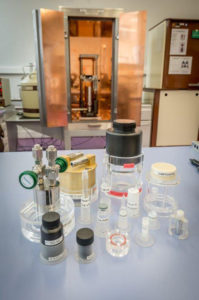
The measurement of radionuclide activity by gamma-ray spectrometry requires calibration in terms of efficiency, which depends particularly on the measurement geometry (type of source, detector and source-detector distance). Its metrological use requires the use of reference standard sources, whose activity is accurately characterized by primary measurement methods available at LNHB, making it possible to achieve relative standard uncertainties less than or equal to 1%.
Preparation and conditioning of these sources is carried out in the laboratory using dedicated facilities. Finally, their precise positioning, which is essential for the reproducibility of measurements, requires the use of specific supports for each type of source. Previously manufactured in PMMA by machining at high cost, these are now designed and produced in the laboratory using additive printing techniques.
If the measurement geometry is different from the calibration geometry, a correction factor is calculated by Monte Carlo method or using the software ETNA, developed at LNHB. This software also enables the calculation of coincidence correction.
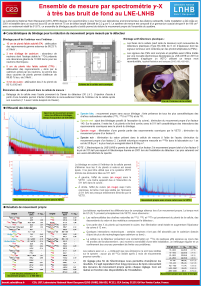
Measurements of environmental samples require special experimental conditions, in particular using a spectrometer with extremely low background noise, in order to achieve detection limits as low as possible.
These samples are measured in an underground laboratory allowing the measurement of low activities (of the order of a few millibecquerels). In particular, it comprises a HPGe detector with a passive multilayer shielding (from the outside to the inside: 10 cm of low-activity lead, 3 mm of cadmium, 5 cm of very-low-activity lead and 4 mm of copper), as well as an active shielding to avoid cosmic radiation (plastic scintillators used as veto and electronics developed at LNHB).
Gamma-ray spectrometry is used for different studies at LNHB:
ISSUE OF COFRAC CERTIFICATE:
LNHB can issue calibration certificates under COFRAC accreditation to laboratories using gamma-ray spectrometry techniques for the measurement of different types of radioactive sources.
CONTROL OF THE PURITY OF RADIOACTIVE SOLUTIONS:
Radioactive solutions may contain impurities, generally inherent to the manufacturing process. Gamma spectrometry makes it possible to identify all the gamma- and X-emitting radionuclides present in any sample, and thus to quantify possible impurities. This information is essential for primary measurement methods and is used in special studies, for example for the optimization of purification processes for radiopharmaceutical solutions.
FUNDAMENTAL NUCLEAR DATA:
Spectrometry measurements are carried out to determine photon emission probabilities of different radionuclides, thereby contributing to the improvement of the radionuclide decay schemes evaluated by DDEP .
Processing software
Various software packages have been developed at LNHB to ensure the detailed processing of spectra and the calculation of corrective factors necessary for accurate quantitative analyses.
REFERENCES:
– J. Riffaud, M.-C. Lépy, P. Cassette, M. Corbel, M.A. Kellett and V. Lourenço, “Measurement of the absolute gamma-ray emission intensities from the decay of 103Pd” (2021) Applied Radiation and Isotopes 167, 109298
DOI: 10.1016/j.apradiso.2020.109298
– M.A. Kellett, L. Vio, C. Bobin, L. Brondeau, M. Cardot-Martin, H. Isnard, D. Lacour, M.-C. Lépy, V. Lourenço, M. Marie and C. Thiam, “Measurement of the absolute gamma-ray emission intensities from the decay of 147Nd” (2020) Applied Radiation and Isotopes Volume 166, December 2020, 109349
DOI: 10.1016/j.apradiso.2020.109349
– M.C. Lépy, C. Thiam, M. Anagnostakis, R. Galea, D. Gurau, S. Hurtado, K. Karfopoulos, J. Liang, H. Liu, A. Luca, I. Mitsios, C. Potiriadis, M.I. Savva, T.T. Thanh, V. Thomas, R.W. Townson, T. Vasilopoulou and M. Zhang, “A benchmark for Monte Carlo simulation in gamma-ray spectrometry” (2019) Applied Radiation and Isotopes 154, 108850
DOI: 10.1016/j.apradiso.2019.108850
– J. Riffaud, P. Cassette, D. Lacour, V. Lourenço, I. Tartès, M.A. Kellett, M. Corbel, M.-C. Lépy, C. Domergue, C. Destouches, H. Carcreff and O. Vigneaud, “Measurement of absolute K X-ray emission intensities in the decay of 103mRh (2018) Applied Radiation and Isotopes 134, 399-405
DOI: 10.1016/j.apradiso.2017.10.003
– M.-C. Lépy, L. Brondeau, Y. Ménesguen, S. Pierre and J. Riffaud, “Consistency of photon emission intensities for efficiency calibration of gamma-ray spectrometers in the energy range from 20 keV to 80 keV” (2018) Applied Radiation and Isotopes 134, 131-136
DOI: 10.1016/j.apradiso.2017.07.006
– L. Ferreux, J. Bouchard, “Improvement of a low-level measurement system used at LNHB”, Applied Radiation and Isotopes 109, 425-429 (2016)
– M. Lépy, A. Pearce, O. Sima, “Uncertainties in gamma-ray spectrometry”, Metrologia 52, S123-S145 (2015)
Our job: metrology
dosimetry
Implemented methods for the establishment of national references must be adapted to the radiation type and its intensity. They are based on measurement technics such as calorimetry, ionometry and chemical dosimetry.
Radioactivity
The variety of the emitted radiation and physical forms of the sources oblige to adapt the measurement process in order to establish national references: methods with defined geometries, or 4 π countings geometries, coincidence countings, etc.
